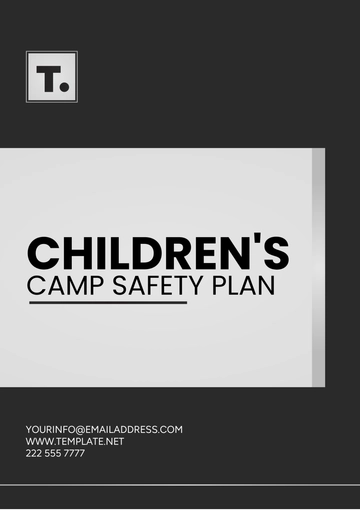Free Onshore Oil Drilling Site Safety Plan

Prepared by: [Your Name]
Company: [Your Company Name]
I. Introduction
The purpose of this safety plan is to ensure a safe working environment for all personnel involved in onshore oil drilling operations. The plan provides a systematic approach to identifying, evaluating, and controlling safety hazards to prevent incidents and injuries.
II. Site Safety Management
A. Roles and Responsibilities
Each team member has specific responsibilities to ensure safety on the drilling site:
Site Manager: Oversees operations and ensures compliance with safety regulations.
Safety Officer: Conducts daily safety briefings and inspections.
Equipment Operator: Operates machinery according to safety protocols.
Workers: Follow all safety guidelines and report hazards.
B. Training and Competency
All personnel must undergo mandatory safety training to ensure they are competent in their roles. Training topics include but are not limited to:
Emergency Response: Procedures for fire, spill, and medical emergencies.
Personal Protective Equipment (PPE): Proper usage and maintenance.
Hazard Communication: Understanding of chemical hazards and Material Safety Data Sheets (MSDS).
III. Hazard Identification and Risk Management
A. Hazard Identification
Hazards must be identified through regular site inspections and risk assessments. Common hazards include:
Slips, trips, and falls
Machinery-related hazards
Chemical exposures
Fire and explosions
B. Risk Management
Control measures are implemented to manage identified risks:
Hazard | Control Measure |
|---|---|
Slips, trips, and falls | Keep walkways clear and provide anti-slip mats. |
Machinery-related hazards | Regular maintenance and use of safety guards. |
Chemical exposures | Use PPE and proper storage procedures. |
Fire and explosions | Implement fire safety protocols and maintain fire suppression systems. |
IV. Emergency Preparedness and Response
A. Emergency Procedures
Procedures for emergencies should include immediate response actions, evacuation routes, and communication protocols. The key components are:
Emergency contact numbers are displayed prominently.
Regular emergency drills to ensure preparedness.
Designated assembly points for evacuations.
B. First Aid and Medical Response
On-site first aid kits must be available, and personnel should be trained in basic first aid. In the event of a serious injury, local medical services should be contacted immediately.
V. Monitoring, Review, and Continuous Improvement
A. Regular Monitoring
Regular monitoring and inspections are essential to ensure compliance with safety standards. The Safety Officer will conduct daily inspections and report findings to the Site Manager.
B. Review and Update
An annual review of the safety plan must be conducted to identify areas for improvement. New hazards and lessons learned from incidents should be incorporated into the plan.
C. Continuous Improvement
Feedback from workers regarding safety practices is encouraged. The goal is to continuously enhance safety measures through innovation and worker participation.
VI. Conclusion
In conclusion, the Onshore Oil Drilling Site Safety Plan is essential for fostering a safe working environment by clearly defining roles, establishing rigorous training protocols, and implementing effective hazard identification and risk management strategies. It emphasizes emergency preparedness and encourages continuous improvement through regular monitoring and feedback. The commitment of every team member to these safety measures is crucial for minimizing risks, protecting personnel, and safeguarding the environment, ensuring that all individuals return home safely at the end of each day.
- 100% Customizable, free editor
- Access 1 Million+ Templates, photo’s & graphics
- Download or share as a template
- Click and replace photos, graphics, text, backgrounds
- Resize, crop, AI write & more
- Access advanced editor
Safeguard your onshore oil drilling operations with the Onshore Oil Drilling Site Safety Plan Template from Template.net. This editable and customizable template is designed to address the specific safety requirements of onshore drilling sites. Easily tailor the content to fit your site's protocols and compliance standards. With a clear structure and comprehensive guidelines, this template helps you effectively communicate critical safety measures, ensuring the protection of your crew and equipment.
You may also like
- Finance Plan
- Construction Plan
- Sales Plan
- Development Plan
- Career Plan
- Budget Plan
- HR Plan
- Education Plan
- Transition Plan
- Work Plan
- Training Plan
- Communication Plan
- Operation Plan
- Health And Safety Plan
- Strategy Plan
- Professional Development Plan
- Advertising Plan
- Risk Management Plan
- Restaurant Plan
- School Plan
- Nursing Home Patient Care Plan
- Nursing Care Plan
- Plan Event
- Startup Plan
- Social Media Plan
- Staffing Plan
- Annual Plan
- Content Plan
- Payment Plan
- Implementation Plan
- Hotel Plan
- Workout Plan
- Accounting Plan
- Campaign Plan
- Essay Plan
- 30 60 90 Day Plan
- Research Plan
- Recruitment Plan
- 90 Day Plan
- Quarterly Plan
- Emergency Plan
- 5 Year Plan
- Gym Plan
- Personal Plan
- IT and Software Plan
- Treatment Plan
- Real Estate Plan
- Law Firm Plan
- Healthcare Plan
- Improvement Plan
- Media Plan
- 5 Year Business Plan
- Learning Plan
- Marketing Campaign Plan
- Travel Agency Plan
- Cleaning Services Plan
- Interior Design Plan
- Performance Plan
- PR Plan
- Birth Plan
- Life Plan
- SEO Plan
- Disaster Recovery Plan
- Continuity Plan
- Launch Plan
- Legal Plan
- Behavior Plan
- Performance Improvement Plan
- Salon Plan
- Security Plan
- Security Management Plan
- Employee Development Plan
- Quality Plan
- Service Improvement Plan
- Growth Plan
- Incident Response Plan
- Basketball Plan
- Emergency Action Plan
- Product Launch Plan
- Spa Plan
- Employee Training Plan
- Data Analysis Plan
- Employee Action Plan
- Territory Plan
- Audit Plan
- Classroom Plan
- Activity Plan
- Parenting Plan
- Care Plan
- Project Execution Plan
- Exercise Plan
- Internship Plan
- Software Development Plan
- Continuous Improvement Plan
- Leave Plan
- 90 Day Sales Plan
- Advertising Agency Plan
- Employee Transition Plan
- Smart Action Plan
- Workplace Safety Plan
- Behavior Change Plan
- Contingency Plan
- Continuity of Operations Plan
- Health Plan
- Quality Control Plan
- Self Plan
- Sports Development Plan
- Change Management Plan
- Ecommerce Plan
- Personal Financial Plan
- Process Improvement Plan
- 30-60-90 Day Sales Plan
- Crisis Management Plan
- Engagement Plan
- Execution Plan
- Pandemic Plan
- Quality Assurance Plan
- Service Continuity Plan
- Agile Project Plan
- Fundraising Plan
- Job Transition Plan
- Asset Maintenance Plan
- Maintenance Plan
- Software Test Plan
- Staff Training and Development Plan
- 3 Year Plan
- Brand Activation Plan
- Release Plan
- Resource Plan
- Risk Mitigation Plan
- Teacher Plan
- 30 60 90 Day Plan for New Manager
- Food Safety Plan
- Food Truck Plan
- Hiring Plan
- Quality Management Plan
- Wellness Plan
- Behavior Intervention Plan
- Bonus Plan
- Investment Plan
- Maternity Leave Plan
- Pandemic Response Plan
- Succession Planning
- Coaching Plan
- Configuration Management Plan
- Remote Work Plan
- Self Care Plan
- Teaching Plan
- 100-Day Plan
- HACCP Plan
- Student Plan
- Sustainability Plan
- 30 60 90 Day Plan for Interview
- Access Plan
- Site Specific Safety Plan





























